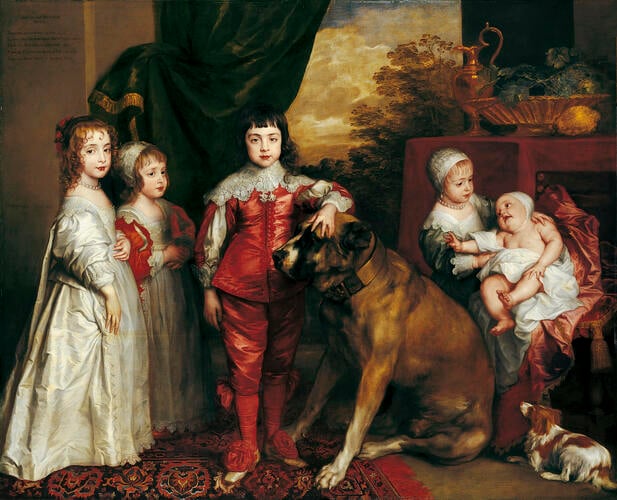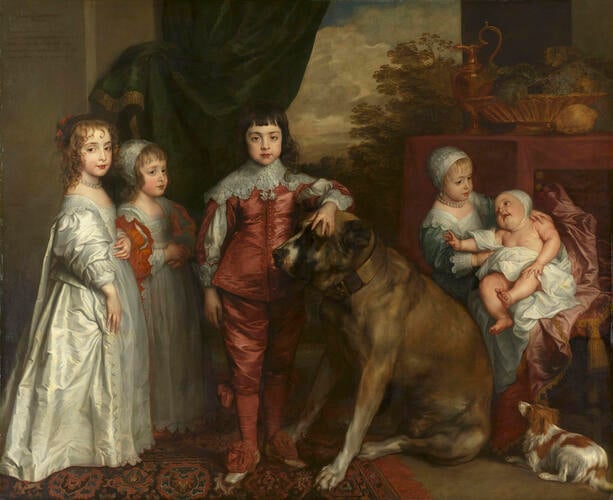-
1 of 253523 objects
The Five Eldest Children of Charles I Signed and dated 1637
Oil on canvas | 163.2 x 198.8 cm (support, canvas/panel/stretcher external) | RCIN 404405
-
Van Dyck’s masterful painting acknowledges both the youth and the status of its royal subjects, breaking with the earlier tradition of presenting royal children as miniature adults. The picture was commissioned by Charles I but left the Royal Collection twice, during the Commonwealth and under James II, before being repurchased by George III in 1765 and hung (by 1774) in the King’s Apartments at Buckingham House. The synthesis that Van Dyck achieved in the portrait was described by the nineteenth-century artist Sir David Wilkie: ‘the simplicity of inexperience shows them in most engaging contrast with the power of their rank and station, and like the infantas of Velasquez, unite all the demure stateliness of the court, with the perfect artlessness of childhood.
George III’s admiration for the early Stuarts and the aesthetic of Charles I’s court was reflected in this purchase and he hung many of his finest Van Dycks in Buckingham House. However, eighteenth-century attitudes towards childhood, which was increasingly regarded as a distinct, innocent phase of life, are reflected in many of the portraits of George III’s children.
George III’s taste for Van Dyck might have been sparked by that of his father, Frederick, Prince of Wales, who had a high regard for the collection of Charles I and had purchased Van Dyck’s double portrait of Thomas Killigrew and William, Lord Crofts, in 1748. Similarly, George IV’s interest in the later Stuarts, and his attempts to reclaim items associated with the exiled dynasty, may equally have been inspired by his father.
Signed and dated Antony van dyck Eques Fecit, / 1637
Catalogue entry adapted from George III & Queen Charlotte: Patronage, Collecting and Court Taste, London, 2004Provenance
Commissioned by Charles I (£100); recorded in the Breakfast Chamber at Whitehall in 1639 (no 1); sold from Hampton Court to Captain Geere on 14 May 1650 for £120 (no 338); purchased by Francis Trion, 17 May 1653; recovered at the Restoration and listed in the Square Table Room at Whitehall in 1666 (no 162); possibly given by James II to the Countess of Dorchester (later 1st Countess of Portmore); her son, 2nd Earl of Portmore; from whom bought by ’Mr Pinchbeck‘; from whom bought by George III, 6 February 1765 for £525 (RA GEO/17131)
-
Creator(s)
Acquirer(s)
Commissioner(s)
Subject(s)
-
Medium and techniques
Oil on canvas
Measurements
163.2 x 198.8 cm (support, canvas/panel/stretcher external)
240.0 x 252.2 x 16.0 cm (frame, external)
Other number(s)
Alternative title(s)
Princess Mary, later Princess of Orange (1631-60), James II when a Prince (1633-1701), Charles II (1630-85) when a Prince, Princess Elizabeth (1635-40) and Princess Anne (1637-40)

